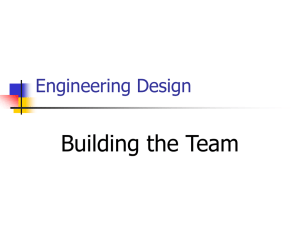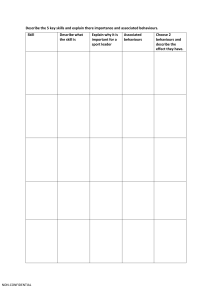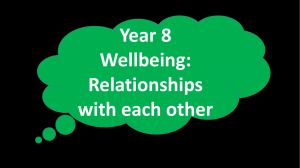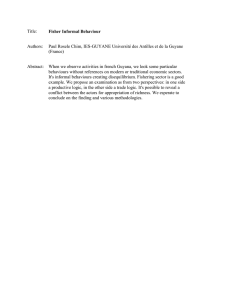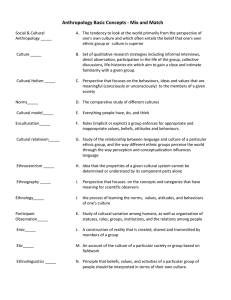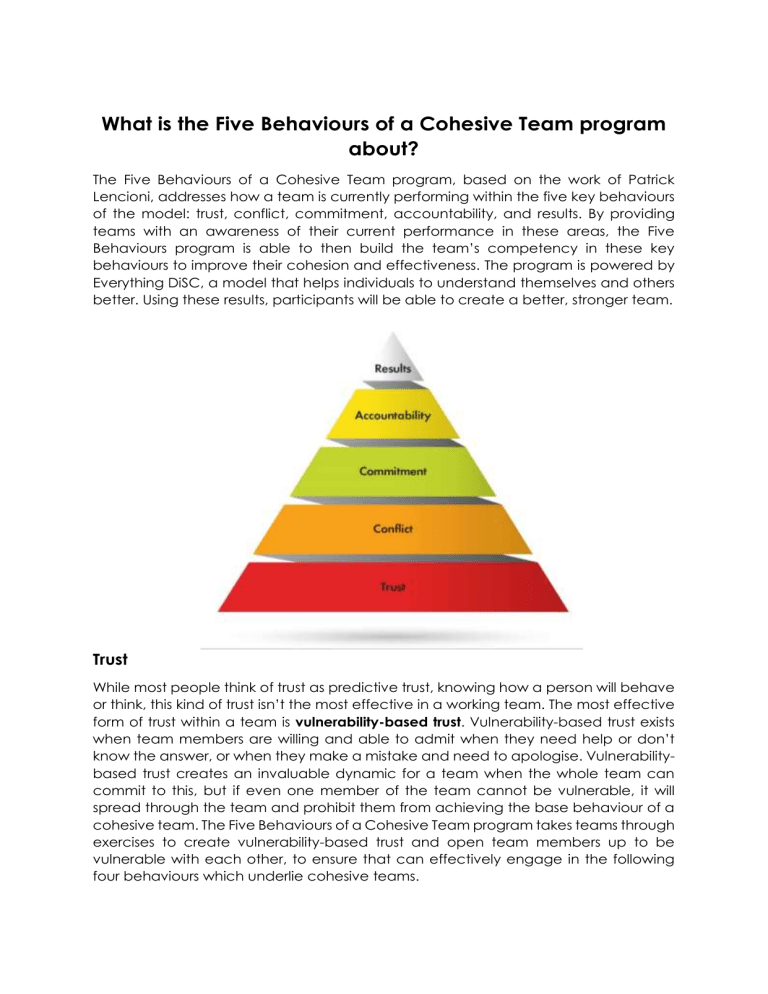
What is the Five Behaviours of a Cohesive Team program about? The Five Behaviours of a Cohesive Team program, based on the work of Patrick Lencioni, addresses how a team is currently performing within the five key behaviours of the model: trust, conflict, commitment, accountability, and results. By providing teams with an awareness of their current performance in these areas, the Five Behaviours program is able to then build the team’s competency in these key behaviours to improve their cohesion and effectiveness. The program is powered by Everything DiSC, a model that helps individuals to understand themselves and others better. Using these results, participants will be able to create a better, stronger team. Trust While most people think of trust as predictive trust, knowing how a person will behave or think, this kind of trust isn’t the most effective in a working team. The most effective form of trust within a team is vulnerability-based trust. Vulnerability-based trust exists when team members are willing and able to admit when they need help or don’t know the answer, or when they make a mistake and need to apologise. Vulnerabilitybased trust creates an invaluable dynamic for a team when the whole team can commit to this, but if even one member of the team cannot be vulnerable, it will spread through the team and prohibit them from achieving the base behaviour of a cohesive team. The Five Behaviours of a Cohesive Team program takes teams through exercises to create vulnerability-based trust and open team members up to be vulnerable with each other, to ensure that can effectively engage in the following four behaviours which underlie cohesive teams. Conflict Once a team is able to demonstrate vulnerability-based trust, it opens the team up to truly understand and benefit from conflict. When conflict is productive, ideological, and focused on ideas, it is a great thing for teams. When a team has developed vulnerability-based trust, it allows conflict to move from what can be seen as negative, interpersonal conflict, to healthy conflict debating ideas and actions, as team members will feel comfortable to speak up. When teams possess vulnerability-based trust, conflict becomes a tool for productivity. The Five Behaviours of a Cohesive Team program utilises tools and exercises such as DiSC profiles to help teams understand how to have healthy conflict to produce ideas and outcomes to reach the best possible solutions. Commitment Sometimes, when teams do not have vulnerability-based trust and the ability to engage in healthy conflict, there can be a tendency to avoid conflict in favour of one person making a decision on behalf of the whole team. This is where healthy conflict becomes crucial, because if people do not weigh-in on a discussion, they are not going to buy-in to the outcomes or actions which come from this. Healthy conflict should not lead to consensus but should ensure that everyone on the team has the opportunity to be heard. This ensures that even if their idea is not the agreed outcome, everyone has had the chance to have their say and can therefore buy-in to the outcome. Without commitment or buy-in, team members can go forward acting contradictorily to the agreed outcome of the discussion as they did not feel they contributed to the decision. The Five Behaviours of a Cohesive Team program helps teams to understand the importance of clarity and buy-in and how these contribute to commitment and utilises tools such as DiSC to help team members understand each other’s’ approach to commitment. Accountability Accountability can often be the hardest of all the five behaviours for teams to adopt. A critical part of forming a cohesive team is to build a dynamic where the members of the team can hold each other accountable for their actions and behaviours, rather than the leader solely being responsible for doing so. Peer pressure on a team is a valuable behaviour as it ensures that the commitments the team makes are seen through. In order for team members to feel comfortable holding one-another accountable to their commitments, these commitments need to have been reached through healthy conflict, based on vulnerability-based trust. When team members hold each other accountable, while it may be challenging and uncomfortable, it ensures that team members have the clarity they need to improve and do their job well. The Five Behaviours of a Cohesive Team program helps teams to understand the link between accountability and productivity and provides tools to help team members effectively hold each other accountable. Results When team members are able to hold one another accountable, they ensure that each member is focused on the collective results of the team, rather than on results for themselves. When people understand that they will be held accountable if they do not behave in ways that align with the goals of the team, they will remain focused on doing that which benefits the team and drives them forwards toward their collective goals. The Five Behaviours of a Cohesive Team program helps teams to develop a common understanding of the team’s expectations, and create tools and process for monitoring progress, to ensure that, going forward, team members will have measures to hold one another accountable to. Sara Redman was one of the first consultants in Tasmania to be accredited in this well-proven program. More information on this model is available at: https://www.youtube.com/watch?v=Rs7bPNslSuc
